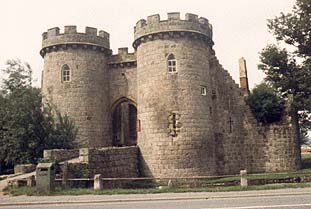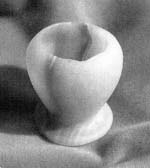
EBK Home
Kingdoms
Royalty
Saints
Pedigrees
Archaeology
King Arthur
Mail David
 The
Marian Chalice
The
Marian Chalice
The Holy
Grail?
The Tradition: At the crucifixion, it was not St. Joseph of Arimathea, but St. Mary Magdalene who tended to Christ and collected his blood in a small cup which thence became known as the "Marian Chalice". It was supposedly found by St. Helen when she excavated Christ's tomb in the early 4th century. It was taken to Rome, but was later removed to Britain when the city was sacked by the Visigoths in AD 410.
 The
Theory: Graham
Phillips believes that the real Holy
Grail was a secret Christian book, the Gospel of Thomas, a
copy of which was discovered in Egypt in 1945. However, he also theorises
that, through the belief that the Grail was a cup, it was confused with
the legendary Marian Chalice. His hypothesis supposes that the chalice
would have been brought to the chief 5th century City of Britain,
Caer-Guricon (Wroxeter), which he and Martin Keatman identify as the
capital of their King Arthur. The great King and his descendants
are therefore seen as the Grail guardians: a lineage which he traces to
Payne Peveril, the original of Percival, and on to his great grandson Sir
Fulk FitzWaryn. Sir Fulk is the subject of a long rambling 13th century
ballad which claims that the Grail was housed in his private chapel at
Whittington Castle in Shropshire. It was removed to Alberbury Priory on
his death, from where a further descendant, Robert Vernon, recovered it in
the late 16th century. It was eventually hidden in a statue of St. John
erected in Hawkstone Park, near the family estate, in the 1850s. Here a
small Roman onyx scent jar was discovered in 1934. Is this the Holy Grail?
The
Theory: Graham
Phillips believes that the real Holy
Grail was a secret Christian book, the Gospel of Thomas, a
copy of which was discovered in Egypt in 1945. However, he also theorises
that, through the belief that the Grail was a cup, it was confused with
the legendary Marian Chalice. His hypothesis supposes that the chalice
would have been brought to the chief 5th century City of Britain,
Caer-Guricon (Wroxeter), which he and Martin Keatman identify as the
capital of their King Arthur. The great King and his descendants
are therefore seen as the Grail guardians: a lineage which he traces to
Payne Peveril, the original of Percival, and on to his great grandson Sir
Fulk FitzWaryn. Sir Fulk is the subject of a long rambling 13th century
ballad which claims that the Grail was housed in his private chapel at
Whittington Castle in Shropshire. It was removed to Alberbury Priory on
his death, from where a further descendant, Robert Vernon, recovered it in
the late 16th century. It was eventually hidden in a statue of St. John
erected in Hawkstone Park, near the family estate, in the 1850s. Here a
small Roman onyx scent jar was discovered in 1934. Is this the Holy Grail?
Possible interpretations & Criticism: Phillips' ideas are long and complicated and his conclusions rely heavily on previous argument, particularly his identification of King Arthur as a supposed ruler of Caer-Guricon named Owain Danwyn (White-Tooth). The Fulk FitzWaryn connection is an intriguing grail-link which has never been satisfactorily explained and Philllips makes a good attempt at explaining it, though the ancestral grail inheritance into the 1850s is not terribly convincing.
